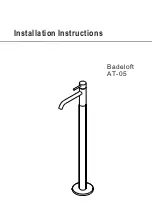
suggested that the APSP standard of salt pond should be at least 3000 to at most 5700-6000 ppm (including
salt).
Cleaning Blades
Remove calcium buildup from the cell before acid cleaning:
Use a garden hose on the spray setup and spray
directly into the ends of the cell. Most of this calcium buildup has a muddy consistency and will be blown out of the
cell. Once most of the calcium has been removed, continue with the acid wash as most of the calcium has been
removed and the acid wash will now be more effective.
Auto Clean:
The CMARCIC series cell has an automatic cell blade cleaning feature (cell reversal) that helps remove
scale deposits from the CMARCIC cell.
Note:
Automatic cleaning does not interrupt chlorine production. “Scale" is a white crusty deposit that forms when
the water is too hard or when the pool water is out of balance and scales. If excessive scale is present on the blade,
acid cleaning is required.
Acid Cleaning:
If the CMARCIC cell blades show a tendency to scale, it is recommended that the CMARCIC cell be
removed and inspected for scale and/or debris formation on the blades every two (2) months. Areas of high
hardness may require more frequent cleaning. Some filters allow debris to pass through the CMARCIC cell and may
become trapped between the blades. A small amount of scale formation is normal. If a look through the CMARCIC
cell reveals excessive scale formation between the blades or the presence of debris, the CMARCIC cell must be
cleaned as follows:
Use a high-pressure water jet from a garden hose. If the blades cannot be reasonably cleaned, disconnect the
AC power from the power center.
Mix one (1) quart of hydrochloric acid with one (1) gallon of tap water in a plastic bucket.
o
Note:
Always wear rubber gloves and goggles when cleaning the CMARCIC cell. Always add acid to
water; do not add water to acid.
Screw the cap with gasket and O-ring onto the threaded end of the CMARCIC cell (cap, o-ring, and gasket are
included with the cleaning kit).
Place the CMARCIC cell horizontally in a five (5) gallon bucket. Pour the acid solution (as described in step)
into the CMARCIC cell until it just covers the cell blades and salinity probe. Allow the acid solution to froth,
then clean the blade.
o
Note:
The acid should only be contained in the CMARCIC cell covering the blade. Try not to sprinkle
acid on the outside of CMARCIC. If acid does spill on the outside of CMARCIC, clean it with water.
The foaming action begins, which is caused by the dissolution of scale (calcium carbonate) from the blade. If
intense foaming is not started, there is no need to clean the blade to stop the cleaning process and continue
to the next step.
o
Otherwise, keep the blade immersed in the solution until the foam stops. However, do not leave the
acid in the CMARCIC cell for more than thirty (30) minutes, leaving it in for a longer period will
damage the blade.
Take the CMARCIC cell out of the barrel and put it into an empty five (5) gallon barrel. Rinse and inspect the
inside and outside of the CFPT by using clean tap water thoroughly. Repeat the acid cleaning process if
deposits are still visible.
After cleaning, replace the cell and return to normal operation.
If an acid cleaning procedure is required, it is recommended that the pool water sample be analyzed by a
pool professional for excessive calcium hardness (i.e., ideal range of 200 to 400 ppm) and/or improper water
balance.
Check the interior of the CMARCIC cell every two (2) months (or more frequently in hard water areas).If no
scale or debris deposits are observed inside the CMARCIC cell after four (4) months, it is not necessary to
check.






































